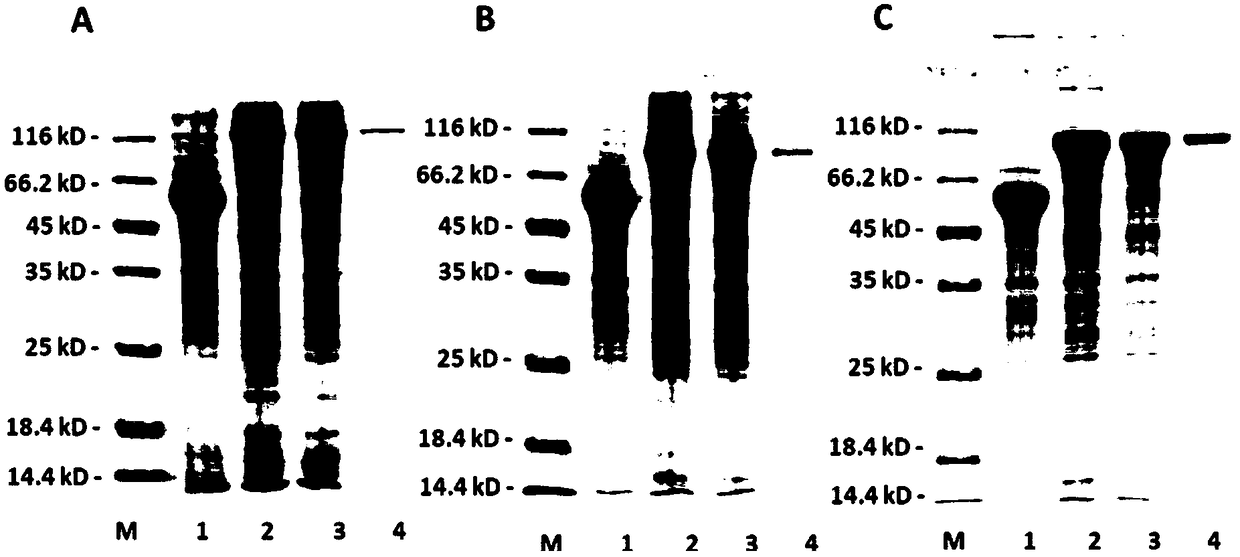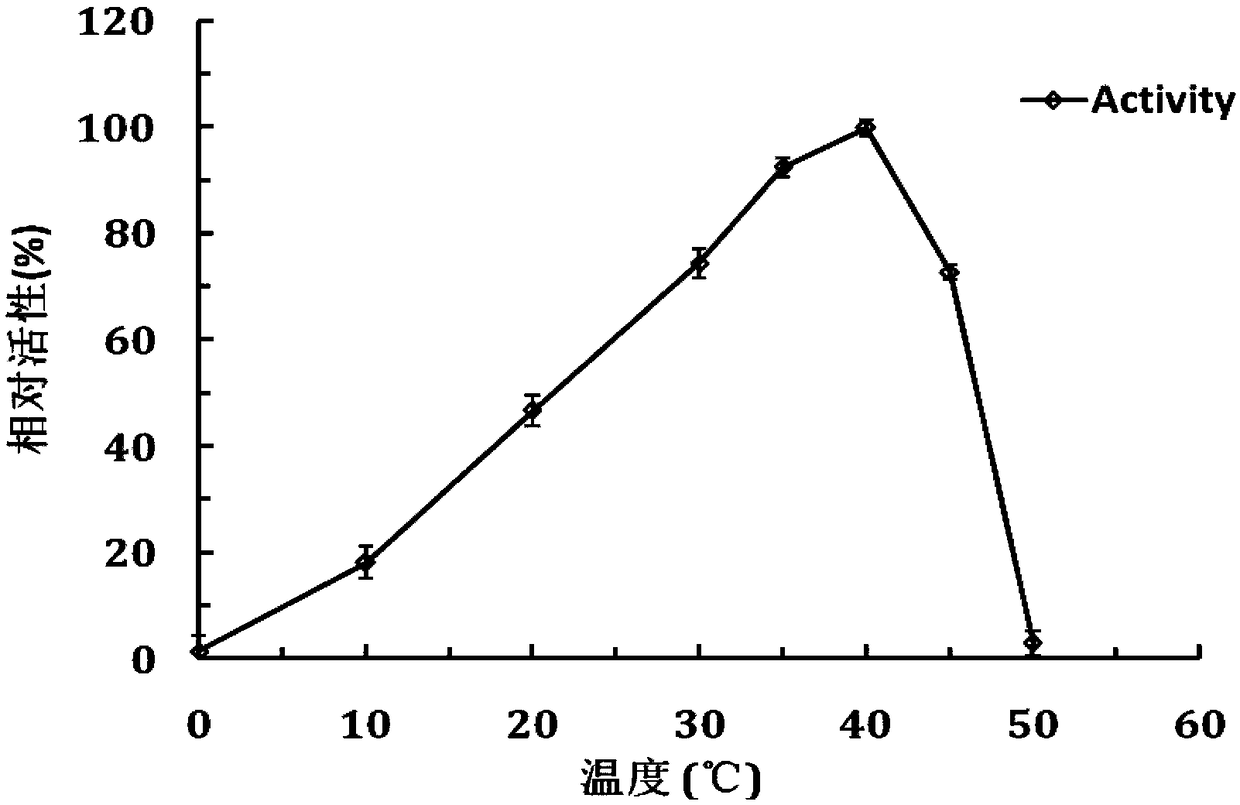M-preferred monosaccharide exo-algin lyase Aly-6 as well as coding gene and application thereof
A technology of alginate lyase and coding gene, which is applied in the direction of lyase, carbon-oxygen lyase, enzyme, etc., can solve the problem that there is no relevant report on the production characteristics of oligosaccharide products, and achieve the effect of stable physical and chemical properties and high activity
- Summary
- Abstract
- Description
- Claims
- Application Information
AI Technical Summary
Problems solved by technology
Method used
Image
Examples
Embodiment 1
[0060] Example 1, Extraction of Flammeovirga yaeyamensis MY04 strain genomic DNA
[0061] Flammeovirga yaeyamensis MY04 was inoculated into liquid medium YT04, and cultured with shaking at 28°C and 200 rpm until the absorbance value at 600 nm (OD 600 ) is 1.2; take 10mL of cultured bacteria, centrifuge at 12,000×g (g, earth’s gravitational constant) for 15min, and collect the bacterial sediment; use 10mL of lysozyme buffer (10mM Tris-HCl, pH 8.0) to suspend the bacterial , and centrifuged at 12,000rmp for 15min to collect the cell pellet.
[0062] The above-mentioned liquid medium YT04 has the following components per liter:
[0063] Tryptone 10g, yeast extract 5.0g, sodium chloride 30g, dissolved in water and adjusted to 1L, pH 7.2.
[0064]Add 6.0 mL of lysozyme buffer solution (purchased from Shanghai Sangon Bioengineering Co., Ltd.) to each tube to obtain about 7.0 mL of bacterial liquid, add 280 μL of lysozyme solution with a concentration of 20 mg / mL, Make the final c...
Embodiment 2
[0065] Example 2. Genome scanning and sequence analysis of Flammeovirga yaeyamensis MY04 strain.
[0066] Genomic DNA prepared in Example 1 was scanned and sequenced by Shanghai Meiji Biotechnology Co., Ltd. using pyrosequencing technology. The DNA sequencing results were analyzed with the online software of NCBI (National Center for Biotechnology Information, http: / / www.ncbi.nlm.nih.gov / ) website. The analysis software used on the NCBI website is Open Reading Frame Finder (ORF Finder, http: / / www.ncbi.nlm.nih.gov / gorf / gorf.html) and Basic Local Alignment Search Tool (BLAST, http: / / blast.ncbi.nlm.nih.gov / Blast.cgi).
[0067] The results analyzed with the above-mentioned biological software show that the genomic DNA of the Flammeovirga yaeyamensis MY04 strain carries an encoding gene aly-6 of alginate lyase, and the coding region of the gene aly-6 is 2238bp long, and the nucleotide sequence is as follows: Shown in SEQ ID NO.1. The recombinant alginate lyase rAly-6 encoded by...
Embodiment 3
[0069] Embodiment 3, the recombinant expression of gene aly-6 and truncated body aly-6Lm, aly-6Hpm in Escherichia coli BL21 (DE3) bacterial strain
[0070] Using the genomic DNA prepared in Example 1 as a template, PCR amplification was performed. The primer sequences are as follows:
[0071] Forward primer for aly-6 amplification Aly6-F: 5'-gg CATATG CAGAACGGAAATTTAATTACTTCCG-3' (NdeI);
[0072] Reverse primer Aly6-R for aly-6 amplification: 5'-gc TCTAGA AATTTCTTCCAATAGGTAAACCCC-3'(XbaI);
[0073] Forward primer for aly-6Lm amplification Aly6Lm-F: 5'-gg CATATG CAGAACGGAAATTTAATTACTTCCGAG-3' (Nde I);
[0074] Reverse primer for aly-6Lm amplification Aly6Lm-R: 5'-gc TCTAGA CAAACTTCTTTTTTGGTAAGTCGTTGC-3' (Xba I);
[0075] Forward primer for aly-6Hpm amplification Aly6Hpm-F: 5'-gg CATATG TACTATTCAAGAGAATTGAAACTAGCC-3' (Nde I);
[0076] Reverse primer for aly-6Hpm amplification Aly6Hpm-R: 5'-gc TCTAGA AATTTCTTCCAATAGGTAAACCCC-3' (Xba I);
[0077] The underlined f...
PUM
| Property | Measurement | Unit |
|---|---|---|
| Theoretical molecular weight | aaaaa | aaaaa |
Abstract
Description
Claims
Application Information
 Login to View More
Login to View More - R&D
- Intellectual Property
- Life Sciences
- Materials
- Tech Scout
- Unparalleled Data Quality
- Higher Quality Content
- 60% Fewer Hallucinations
Browse by: Latest US Patents, China's latest patents, Technical Efficacy Thesaurus, Application Domain, Technology Topic, Popular Technical Reports.
© 2025 PatSnap. All rights reserved.Legal|Privacy policy|Modern Slavery Act Transparency Statement|Sitemap|About US| Contact US: help@patsnap.com



